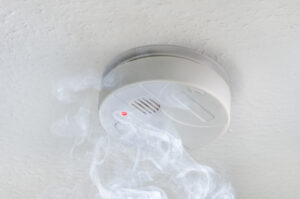
Things That Keep Building Safety Professionals Up at Night
Outlining a few of the top concerns, and their respective solutions, that building safety professionals would like homeowners and business owners to understand.
From building inspectors to fire marshals, building safety professionals are key in keeping our homes, schools and businesses safe. As the silent defenders of public safety, they work to ensure that buildings are constructed and maintained to withstand the stresses of both everyday use and potentially disastrous events, such as earthquakes, fires or tornados.
These highly trained professionals are on the front lines of building safety and have witnessed firsthand the dangers of homes and businesses not being constructed and maintained to modern safety codes and standards.
Here we’ve outlined a few of the top concerns, and their respective solutions, that building safety professionals would like homeowners and business owners to understand. To hear more from these professionals, read 7 Things Code Inspectors Wish Homeowners Knew.
Obstructed Escape Routes
Having a means of egress – an unobstructed path to exit in the event of an emergency – is a critical part of basic building safety.
Exit routes built into homes and businesses should be safe and accessible for all occupants, including those with disabilities. Property owners should regularly check that exits aren’t being blocked by furniture or seasonal décor. Storing items near critical escape areas of a residence or business can put people at risk during an emergency.
Building safety professionals can help homes and businesses comply with applicable safety codes, standards and regulations, including those related to a means of egress. Through building and home inspections, these professionals can identify potential safety hazards resulting from inadequate or non-existing exit routes and provide guidance on how to create and maintain a safe means of egress.
Expired Smoke Alarms
Smoke alarms serve as a critical early warning system in the event of a home fire and should be in all bedrooms and on every level of a home. It is important to conduct regular maintenance and testing on all your alarms to confirm they are in good working condition.
Smoke alarms have become increasingly important as the intensity and frequency of home fires has risen. Due to the rise of electronics and batteries used in homes (more on this below), changing floor plan layouts and the prevalence of potential fuel sources like plastics and synthetic fabrics, home fires have been spreading faster and burning hotter than ever before.

Not Having Enough CO Alarms
Building safety professionals have also been witnessing increased issues with carbon monoxide (CO), a colorless and odorless gas that can cause serious illness or death when inhaled in high concentrations.
After a large storm or disaster, many areas will experience a loss of power which can often lead to the improper use of generators. These instances have been more prevalent as the intensity and frequency of disasters have increased over the years. If a generator is set up or used incorrectly, it could generate dangerous CO leaks in homes and businesses, putting the occupants of the building at serious risk.
Similarly, in the case of a power outage due to a heavy snowstorm, snow can potentially block the exhaust of CO from a generator, causing another safety hazard to occupants. Note that improperly maintained (such as a leaky chimney), installed and aging fuel-burning appliances can also contribute to potential CO leaks.
It is recommended to have at least one CO alarm on every level of a home, and some states may even require combined smoke alarms and CO alarms. Check with your local building department for official requirements. Learn more about how to protect your home from fire here
Being Unprepared for Wildfires
Not everyone currently lives in a Wildland Urban Interface (WUI) area, however, the WUI is growing by approximately 2 million acres per year. We recommend understanding the dangers of wildland fires and how to implement preventative measures to mitigate their potential.
Embers from wildland fires can travel up to 40 miles, but there are steps that individuals living in one- and two-family dwellings can take to help reduce this spread.
- Be aware of the fire safety regulations and restrictions for your community
- Keep your property clear by removing any combustibles from around the house, such as dry vegetation, dead leaves and other flammable materials
- Be cautious when using fire outdoors
Not Working with Your Building Department for DIY Home Improvement Projects
When doing any home renovation or DIY projects, it is essential you keep the structural integrity of your house intact. Any alterations made to load-bearing walls or the foundation can severely compromise the structural safety of your house or business.
Occupants should be using the structure of the building as intended by its design and construction. For example, the attic or story over the garage may not be designed to bear a living space, so they should not be used as such.
Furthermore, DIY projects that involve electrical, plumbing or fuel gas systems can be dangerous if not done correctly, leading to potential hazards such as fires or explosions. When taking on work related to fuel gas, turn off the gas supply and be careful when opening up walls to avoid a potential leak.
For any construction or renovation projects, you should contact your building department before any work is done to secure any necessary permits required to do the work. Requirements vary, but most building departments require permits for home improvement projects, including electrical, mechanical, structural or plumbing work. Read about the importance of following building codes during a DIY project here.
Charging Your Battery-Powered Devices Incorrectly
Almost all battery-powered appliances in our homes contain lithium-ion batteries. The safety of these batteries is improving, but users still need to ensure they are operating them correctly.
Proper charging with listed or manufacturer-approved chargers is key. Additionally, when charging micro-mobility devices such as scooters and e-bikes, plug directly into the electrical receptacle and not through multiplug adaptors or extension cords.
Equally importantly, do not locate these hazards in front of an exit.
The International Code Council is Here to Help
By making sure your home complies with applicable codes, standards and key safety measures, you can take proactive steps to reduce the risk of disastrous events.
Click here to learn more about fire safety tips and how to protect your home environment.







